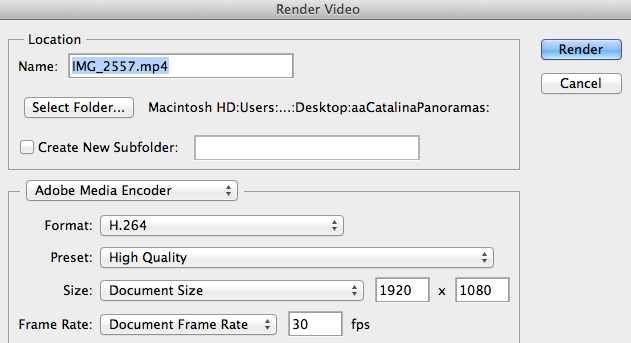Review: Video Editing in Adobe Photoshop CS6
A new feature in Adobe Photoshop CS6 allows editing and rendering for streaming, and includes keyframeable effects and clip-layering.
Rendering the Video
Once your masterpiece is complete, with titles and audio and video transitions, prepare it for online delivery by choosing Export > Render Video (Figure 11, below). This prompts a dialog box that's more akin to the old QuickTime export dialog box than to any of Adobe's current video transcoding tools, but underneath the surface is the robust Adobe Media Encoder CS6.

Figure 11. Choose Export options to bring up encoding options.
The dialog box (Figure 12, below) features a number of options that Media Encoder offers, including Flash Video 8 and H.264 output, as well as frame resizing and frame rate adjustments.

Figure 12. The Video Export dialog box
You'll have to hunt through all these options, though, to get a good set of encoding parameters. With all the work that's gone into the CS6 version of Adobe Media Encoder's user interface, none of that ease-of-use has made it in to this version of Photoshop. For instance, Photoshop includes an option to limit the range of frames rendered, but restricts that option to pure frame-number increments (Figure 13, below), meaning that choosing 2 seconds isn't an option, but choosing 0-60 frames is an option (assuming that 29.97 frames per second rounds up to 30 frames per second within CS6 Photoshop).

Figure 13. Choosing a frame range
The Bottom Line
So what's our take on Adobe's inclusion of video editing and export functions in Photoshop? We think the idea holds significant merit, since even Apple's built-in iPhoto program imports video but does nothing more with it. For those who have never used video editing tools, the Photoshop version is adequate, but the odd naming conventions, layer/frame metaphors, and other non-standard tools may eventually hinder the progress of those pro photographers who might later upgrade to Premiere Elements or Premiere Pro.
Related Articles
Adobe Photoshop Touch, optimized for iPhone, iPod touch, and Android smart phones, brings core features of Photoshop desktop software to mobile devices and offers similar intuitive, touch-based gestures and features
Jan Ozer sits down with Bill Roberts to discuss the trends impacting the future direction of Adobe Creative Suite for video pros, including the decline of 3D, the rise of 4K, and second-screen viewing. Other topics included the growth of Creative Cloud, and the development arc of Apple Final Cut Pro X.
In the final installment of the NAB Interviews with Shawn Lam, Shawn talks with Adobe's Al Mooney about key new features in Premiere Pro CS6 and Adobe Media Encoder.